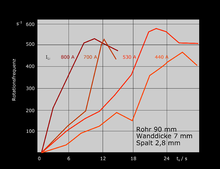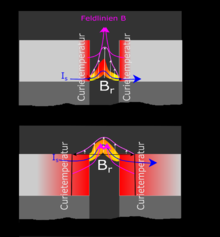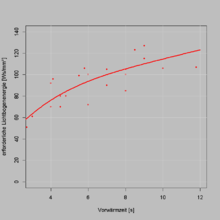MBP welding
The MBP welding ( pressure welding with a magnetically moved arc ) is an arc pressure welding process according to DIN 1910-100: 2008-02, and has the order number 185 according to EN ISO 4063. The procedure is as MBL or Magnetarc welding , respectively. In the English language literature, it is known as MIAB Welding ( magnetically impelled arc butt welding ).
With this process, hollow profiles are butt welded under protective gas. An arc is ignited between the surfaces to be joined and caused to move in a magnetic field along the edges of the joint. The edges heat up and melt. Subsequent upsetting leads to a pressure welded connection with a uniform upset bulge, which is usually not processed. It is welded with direct current . Additional materials are not required.
Physical principle
The Lorentz force moves the arc along the joining edges. It arises from the interaction of an external radial magnetic field perpendicular to the direction of the arc current with the arc's own magnetic field. If the arc with a constant arc current is viewed in simplified form as a compact electrical conductor of length , on which a constant magnetic flux density acts, the Lorentz force can be written as:
or, if an angle between the flux density of the external magnetic field and the current direction is taken into account:
- .
The arc burns in the air gap between the parts to be joined and moves with increasing speed after ignition. The edges of the parts to be joined heat up until melt forms on the end faces and a sufficient temperature gradient is established in the interior of the two parts. Compression of the parts results in a welded joint.
Process flow
Welding goes through four process stages:
In the starting position, the workpieces touch and the welding current and the magnetic field are switched on. At the start of welding, the workpieces are moved back to a defined gap between the edges of the parts to be joined. The arc ignites and moves along the inner edges with increasing speed. When heated, the arc accelerates from the inner edges to the outside. The maximum rotation is reached when an equilibrium is established between the force accelerating the arc and the dynamic pressure acting on the column surface. It depends on the arc current. If melt forms on the edges, the speed of rotation is inhibited. The material is heated until the edges melt. The wing ponds are pulled together and compressed at the end of the welding process. The magnetic field and the welding current are switched off.
Welding parameters
Lift
The arc is ignited by moving backwards. The set gap width determines the arc length and thus the welding voltage, the arc mobility (rotation speed) and the arc stability.
Welding and solenoid current
Changes to the welding and magnet coil currents during the process can lead to optimization of the ignition and heating process (welding with the current program). Power programs have proven particularly useful when welding parts with a greater wall thickness.
Welding with the power program is carried out in three phases:
- Ignition and start-up phase for safe and even start-up of the arc movement.
- Warm-up phase for even and deep warming of the joining area.
- Melting phase for melting and cleaning the abutting surfaces before upsetting by means of a sudden increase in current.
Upsetting force
The workpieces are welded by upsetting with a preselectable force, with the upsetting speed significantly influencing the quality of the connection. To ensure a defined final length of the welded component, it can be compressed against a stop. Attention must be paid to the loss of material in the melting phase in order to achieve sufficient material deformation.
Protective gas
Protective gas is used in unalloyed and low-alloy steels to stabilize the arc in order to improve the reproducibility of the ignition and running behavior and the appearance of the bead. It does not have the task of shielding the welding point from the atmosphere and thus protecting it against oxidation and pore formation.
Welding process control and regulation
In the ignition and heating phases, stochastic changes in the arc current, the arc voltage or the rotation speed can influence the heating process. The arc voltage changes as the arc length changes. This depends not only on the width of the gap between the parts to be joined, but also on the strength and shape of the magnetic field in the air gap and on the degree of ionization (gas composition, gas temperature, proportions of metal vapor in the arc environment). The shape and position of the magnetic field and thus the radial components that drive the arc change when the edges of the parts to be joined are heated to temperatures above the Curie temperature , which increases the “magnetic air gap”. After igniting, the arc moves along the inner edges of the parts to be joined, as this is where the arc deflection due to the magnetic field is lowest (in accordance with the minimum principle of arc voltage described by M. Steenbeck ). As the edge heating begins, it migrates to the outer edges. Voltage changes of up to 4 V can occur within the heating cycle, which lead to changes in energy consumption.
By controlling and / or regulating the welding parameters arc current , magnetic current , air gap and heating time, an attempt is made to achieve reproducible energy input and thus constant welding quality.
The point in time at which the melting temperature of the welding edges is reached depends on the energy introduced by the arc . The aforementioned changes in current , voltage and efficiency make it necessary to adjust the time to the current conditions. Starting from a known function , the warm-up time can be controlled if the voltage and current are measured, the actual value is calculated in real time and compared with the setpoint model.
The smoothed arc voltage runs through a typical cycle during the warm-up time. It rises first, passes through a maximum, and then falls again. When the edges begin to melt, the arc voltage has reached a minimum that can be used to control the point in time .
A regulated welding device for welding with a magnetically moving arc is described in utility model DE 202008005534U1. With the welding device described, the axial distance between the parts to be joined can be controlled or, if necessary, regulated during the heating time, in order to influence the heating and melting process in a targeted manner. This can be done independently or in coordination with a welding current control or magnetic field influence.
Weldability of materials
There are empirical values available about the weldability of unalloyed and alloyed steels using MBP welding, as well as of cast iron and cast steel. Due to the bulging of the liquid phase from the joining zone and the cooling under the action of force, the susceptibility of the connection to cracks is low, which is advantageous when welding steels with a higher carbon content and free-cutting steels. Hardened or quenched and tempered steels lose part of their hardness or strength in the heat affected zone due to MBP welding. In the case of surface-coated (galvanized or chrome-plated) joining parts, it must be ensured that the abutting surfaces are uncoated.
Material geometry
Tubular cross-sections with a cross-sectional area of up to 2300 mm², wall thicknesses of up to 6 mm and pipe diameters of up to 140 mm can be joined using MBP welding. In Russia, a portable welding system is to be used for pipeline construction, which welds pipes with a diameter of 529 mm.
credentials
- ↑ a b DIN 1910-100: 2008-02 Welding and related processes - Terms - Part 100: Metal welding processes with additions to DIN EN 14610: 2005.
- ↑ DVS : "Pressure welding with magnetically moving arc (MBP welding)" DVS Merkblatt 2934, 2001.
- ↑ EN ISO 4063: 2011-03 Welding and allied processes - List of processes and serial numbers.
- ↑ a b Гаген Ю.Г., Таран В.Д .: Сварка магнитоуправляемой дугой. In: Машиностроение. 1970 (Ju.G. Gagen, WD Taran: Welding with a magnetically controlled arc. In: Mashinostrojenie. 1970.).
- ↑ a b c M. Schellhase: The welding arc as a technological tool. VEB Verlag Technik, Berlin, 1985.
- ↑ Patent DE1565041 : welding machine with rotating arc. Inventor: D. Sciaky (B23k 11/04).
- ↑ Patent DD129179A1 : Process for MBL pressure welding of closed cross-sections. Inventors: H. Krohn, J. Burmeister, HJ Posselt (B23K9 / 08).
- ↑ Patent GB2094694A : Method and apparatus for arc butt welding. Inventor: DA Edson (B23K9 / 08).
- ↑ a b J. Burmeister: Automatic quality assurance for MBL welding. Diss. TH Karl-Marx-Stadt (Chemnitz), 1984, DNB 941807835 .
- ↑ Patent EP0409990A1 : METHOD OF PRESS WELDING WITH HEATING BY MEANS OF AN ARC MOVING IN A MAGNETIC FIELD. Published on 1991 , inventor S. Kuchuk-Yatsenko, et al
- ↑ Utility model DE202008005534U1 : welding device . Published on 2009 , applicant: KUKA Systems GmbH.
- ↑ F. Trommer: MagnetArc welding - process overview and industrial applications ( Memento of the original from April 29, 2014 in the Internet Archive ) Info: The archive link was automatically inserted and not yet checked. Please check the original and archive link according to the instructions and then remove this notice. . 2nd symposium on Sensitive Manufacturing Technology, Magdeburg-Stendal University of Applied Sciences, 2013.
- ↑ Большая Энциклопедия Нефти и Газа: Дугоконтактная сварка (Russian; Great Encyclopedia of Petroleum and Natural Gas: Arc pressure welding )


























